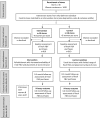Protocol of a natural experiment to evaluate a supermarket intervention to improve food purchasing and dietary behaviours of women (WRAPPED study) in England: a prospective matched controlled cluster design
- PMID: 32047023
- PMCID: PMC7044911
- DOI: 10.1136/bmjopen-2020-036758
Protocol of a natural experiment to evaluate a supermarket intervention to improve food purchasing and dietary behaviours of women (WRAPPED study) in England: a prospective matched controlled cluster design
Abstract
Introduction: Poor diet is a leading risk factor for non-communicable diseases and costs the National Health Service £5.8 billion annually. Product placement strategies used extensively in food outlets, like supermarkets, can influence customers' preferences. Policy-makers, including the UK Government, are considering legislation to ensure placement strategies promote healthier food purchasing and dietary habits. High-quality scientific evidence is needed to inform future policy action. This study will assess whether healthier placement strategies in supermarkets improve household purchasing patterns and the diets of more than one household member.
Methods and analyses: This natural experiment, with a prospective matched controlled cluster design, is set in discount supermarkets across England. The primary objective is to investigate whether enhanced placement of fresh fruit and vegetables improves household-level purchasing of these products after 6 months. Secondary objectives will examine: (1) differences in intervention effects on purchasing by level of educational attainment, (2) intervention effects on the dietary quality of women and their young children, (3) intervention effects on store-level sales of fruit and vegetables and (4) cost-effectiveness of the intervention from individual, retailer and societal perspectives. Up to 810 intervention and 810 control participants will be recruited from 18 intervention and 18 matched control stores. Eligible participants will be women aged 18-45 years, who hold a loyalty card and shop in a study store. Each control store will be matched to an intervention store on: (1) sales profile, (2) neighbourhood deprivation and (3) customer profile. A detailed process evaluation will assess intervention implementation, mechanisms of impact and, social and environmental contexts.
Ethics and dissemination: Ethical approval was obtained from the University of Southampton, Faculty of Medicine Ethics Committee (ID 20986.A5). Primary, secondary and process evaluation results will be submitted for publication in peer-reviewed scientific journals and shared with policy-makers.
Trial registration number: NCT03573973; Pre-results.
Keywords: health economics; nutrition & dietetics; preventive medicine; public health.
© Author(s) (or their employer(s)) 2020. Re-use permitted under CC BY. Published by BMJ.
Conflict of interest statement
Competing interests: This study involves a non-financial collaboration with Iceland Foods. CV, SC, PD, CS, JC, GM, JL and KB have no conflicts of interests to declare and no further financial disclosures to make. JB and WL have received grant research support from Danone Nutricia Early Life Nutrition. CC has received consultancy, lecture fees and honoraria from AMGEN, GSK, Alliance for Better Bone Health, MSD, Eli Lilly, Pfizer, Novartis, Servier, Medtronic and Roche. The study described in this manuscript is not related to these relationships.
Figures


Similar articles
-
Implementation of a UK supermarket intervention to increase purchasing of fresh fruit and vegetables: process evaluation of the WRAPPED natural experiment.Int J Behav Nutr Phys Act. 2024 Nov 11;21(1):128. doi: 10.1186/s12966-024-01679-3. Int J Behav Nutr Phys Act. 2024. PMID: 39529139 Free PMC article. Clinical Trial.
-
Altering product placement to create a healthier layout in supermarkets: Outcomes on store sales, customer purchasing, and diet in a prospective matched controlled cluster study.PLoS Med. 2021 Sep 7;18(9):e1003729. doi: 10.1371/journal.pmed.1003729. eCollection 2021 Sep. PLoS Med. 2021. PMID: 34491999 Free PMC article.
-
A four-year observational study to examine the dietary impact of the North Carolina Healthy Food Small Retailer Program, 2017-2020.Int J Behav Nutr Phys Act. 2021 Mar 24;18(1):44. doi: 10.1186/s12966-021-01109-8. Int J Behav Nutr Phys Act. 2021. PMID: 33761952 Free PMC article.
-
Folic acid supplementation and malaria susceptibility and severity among people taking antifolate antimalarial drugs in endemic areas.Cochrane Database Syst Rev. 2022 Feb 1;2(2022):CD014217. doi: 10.1002/14651858.CD014217. Cochrane Database Syst Rev. 2022. PMID: 36321557 Free PMC article.
-
Environmental interventions to reduce the consumption of sugar-sweetened beverages and their effects on health.Cochrane Database Syst Rev. 2019 Jun 12;6(6):CD012292. doi: 10.1002/14651858.CD012292.pub2. Cochrane Database Syst Rev. 2019. PMID: 31194900 Free PMC article.
Cited by
-
Development of two short FFQ to assess diet quality in UK pre-school and primary school-aged children based on National Diet and Nutrition Survey data.Br J Nutr. 2025 May 14;133(9):1287-1296. doi: 10.1017/S0007114525103449. Epub 2025 May 19. Br J Nutr. 2025. PMID: 40383982 Free PMC article.
-
Implementation of a UK supermarket intervention to increase purchasing of fresh fruit and vegetables: process evaluation of the WRAPPED natural experiment.Int J Behav Nutr Phys Act. 2024 Nov 11;21(1):128. doi: 10.1186/s12966-024-01679-3. Int J Behav Nutr Phys Act. 2024. PMID: 39529139 Free PMC article. Clinical Trial.
-
Real-life experiments in supermarkets to encourage healthy dietary-related behaviours: opportunities, challenges and lessons learned.Int J Behav Nutr Phys Act. 2023 Jun 20;20(1):73. doi: 10.1186/s12966-023-01448-8. Int J Behav Nutr Phys Act. 2023. PMID: 37340326 Free PMC article.
-
Women Consumers' Views on Legislation to Restrict Prominent Placement and Multibuy Promotions of High Fat, Sugar, and Salt Products in England: A Qualitative Perspective.Int J Health Policy Manag. 2023;12:7597. doi: 10.34172/ijhpm.2023.7597. Epub 2023 Sep 10. Int J Health Policy Manag. 2023. PMID: 38618804 Free PMC article.
-
UK government's new placement legislation is a 'good first step': a rapid qualitative analysis of consumer, business, enforcement and health stakeholder perspectives.BMC Med. 2023 Jan 26;21(1):33. doi: 10.1186/s12916-023-02726-9. BMC Med. 2023. PMID: 36703194 Free PMC article.
References
-
- Bates B, Collins D, Cox L, et al. . National diet and nutrition survey, years 1 to 9 of the rolling programme (2008/2009 – 2016/2017): time trend and income analyses. London, 2019.
-
- Food Standards Agency The 2014 food and you survey. London, 2014.
-
- Barker DJP. Nutrition in the womb: how better nutrition during development will prevent heart disease, diabetes and stroke. 1st ed USA, 2008.
Publication types
MeSH terms
Associated data
Grants and funding
LinkOut - more resources
Full Text Sources
Medical
